A century of political ephemera: A window onto Queensland politics from 1915-2015
By JOL Admin | 15 June 2017
Guest blogger: Dr Lorann Downer - 2016 John Oxley Library Fellow.
The Queensland state election of 1989 is famous for bringing down the curtain on 32 years of conservative administration and ushering in the Goss Government and a raft of democratic reforms. But it’s also significant for another, lesser-known reason. This election also marks the full bloom of political marketing in Queensland.
Very simply, political marketing is the application of commercial marketing principles and techniques to politics. A marketing framework – that sees parties, politicians and policies as products, and voters as consumers in a market – is used to analyse political behaviour.
Political marketing emerged from mid last-century for a variety of reasons. Voters began to turn away from traditional parties, party ideology became more flexible, and campaigning became more professional especially with the introduction of television. Some political scientists saw that political behaviour was changing, and to describe and explain what they were witnessing, they drew on a three-stage model of development from the business world. Thus, a product-oriented party, with a rigid ideology, will simply argue for what it believes in. A sales-oriented party, also ideological, will try to persuade voters to agree with its views. A market-oriented party, however, will try to meet the needs and wants of voters by changing its own behaviour including its policies and even its leaders.
Political marketing is a fact of life in all western democracies. We can trace its development in each jurisdiction by studying the behaviours of parties and politicians, including the ephemera they produce for elections. Ephemera includes how to vote cards, posters, pamphlets, direct mail, calendars, stickers, magnets, t shirts and caps. This material speaks volumes about how parties and politicians view and try to reach voters.
Over the past year, I have researched the rich ephemera collections of the John Oxley Library to document and share the story of political marketing in Queensland from 1915 to 2015. During the early decades of last century, we see parties consistently offering their ideologically-driven products with a bit of a ‘take it or leave it’ attitude to voters. From the 1930s onwards, we see political leaders being increasingly promoted to help humanise and ‘sell’ parties and policies. And by 1989 we witness the major parties operating as professional political marketing organisations.
Looking across the ephemera from 1915, ideology is front and centre. This is evident from the focus on parties and policies rather than leaders. This is a piece (Image 1) from Labor ahead of the poll, which saw the election of Thomas Joseph Ryan who was a capable, vigorous and popular leader. But Ryan isn’t mentioned at all. Instead voters are urged to: “Work for Labor, Vote for Labor, Assist Labor’s candidates.”
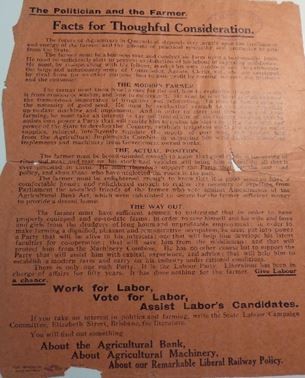
Image 1 - From SLQ's political ephemera collection
The pattern continues at the 1918 election. This piece (Image 2) trumpets Labor’s policy achievements in 26 areas after three years in office, and urges voters to support Labor once more. Their conservative opponents, meantime, warn of pending financial disaster under continuing Labor administration and urge people to vote for the Nationalist candidates. (Image 3)
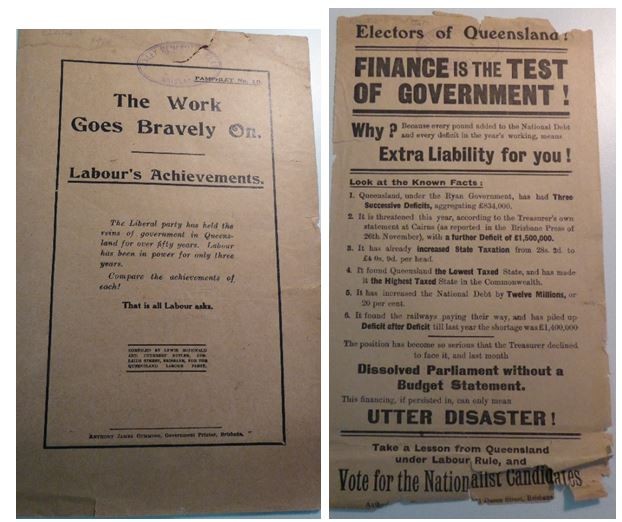
Images 2 and 3 -From SLQ's political ephemera collection
Pieces from this era of product-oriented politicking are also notable for their length and detail. One collection of 22 pamphlets from Labor in 1918 is instructive. Many of the pieces are four pages long and three run to eight pages. Most contain detailed discussion of policies, and include tables of figures, excerpts from the Queensland Parliament’s Hansard records or passages from newspapers. If that isn’t enough, readers are sometimes invited to write to the party for even more information!
Over the next few decades, we start to see a shift to sales-oriented campaigning. One mark of this is that we see leaders being featured. In this piece from 1929 (Image 4), the surname of the Country Party leader, Edward Moore, is used in the rhyming campaign slogan: ‘Make sure vote Moore’.
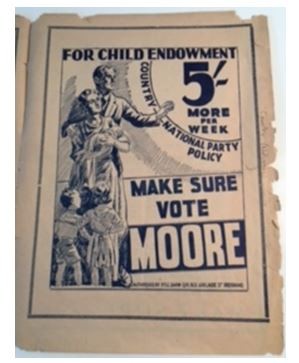
Image 4 - From SLQ's political ephemera collection
This 1935 pamphlet (Image 5) produced by Labor shows both the leaders and the party. On the left is the conservatives’ Edward Moore, grim-faced beside a scale laden with his ‘Failure’, and on the right is Labor’s William Forgan Smith, cheerfully observing a scale loaded with his ‘Achievements’. Below is a table which succinctly compares the records of each party on seven key policies. On the back of this leaflet is the simple message: ‘Vote Labor Again’. The messages are pared down and visual, easy to digest and recall.
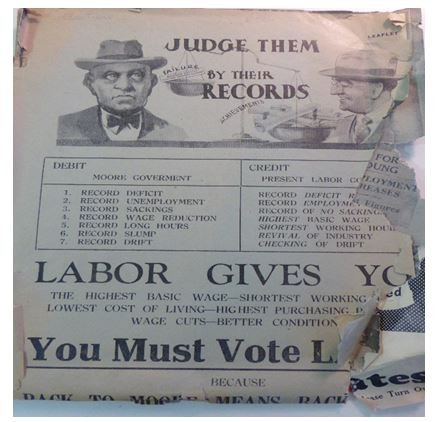
Image 5 - From SLQ's political ephemera collection
Communist leader, Jack Henry, is featured in a headshot on the front page pf this pamphlet which sets out the party’s manifesto ahead of the 1938 state election. While the inclusion of the leader is a nod to a sales orientation, the ideologically-driven text is very much in a product oriented mode. (Image 6)
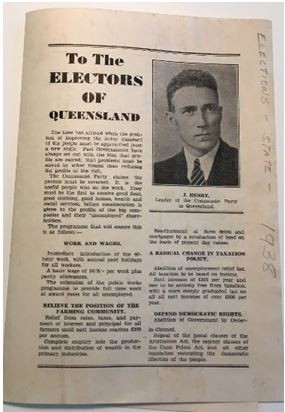
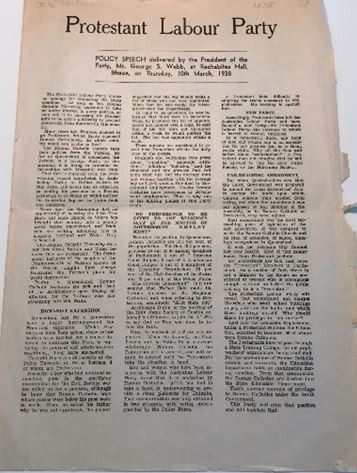
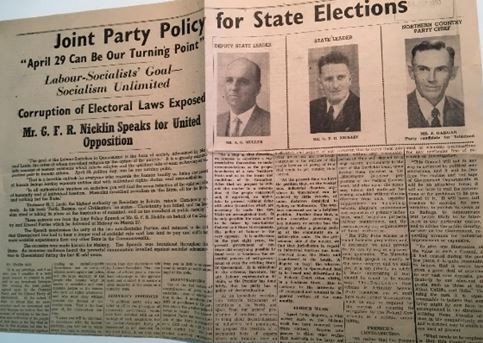
Image 8 - From SLQ's political ephemera collection
A lot of politicking was done at public rallies where speakers would try to sell their policies to voters. This 1938 flyer from the Social Credit Party invites people to a public meeting to hear “silver tongued orator”, John Hogan and “Brisbane’s leading lecturess”, Mrs F. S. Chapman. (Image 9) This flyer from 1957 advertises a Labor rally at Trades Hall in Brisbane featuring leader, Jack Duggan, which is billed as “a most vital and important meeting”. (Image 10)
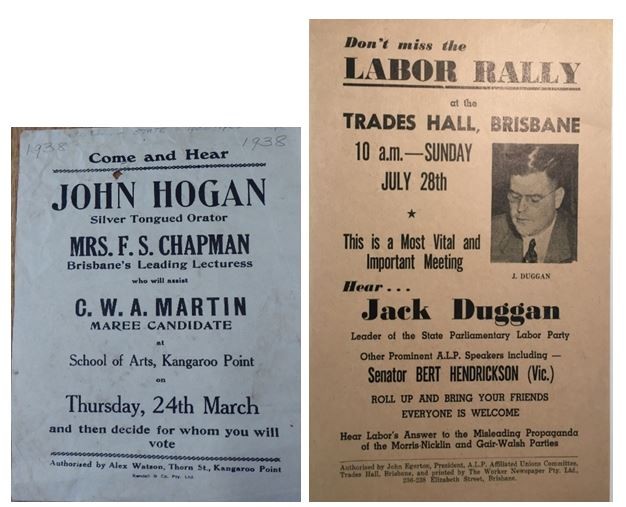
Images 9 and 10 - From SLQ's political ephemera collection
From about mid-century, we see a more market-oriented approach from many parties, leaders and candidates. There were more personalised pitches, such as this from Labor’s candidate in South Brisbane in 1960, Col Bennett, who is featured with his wife and their eight children. (Image 11)
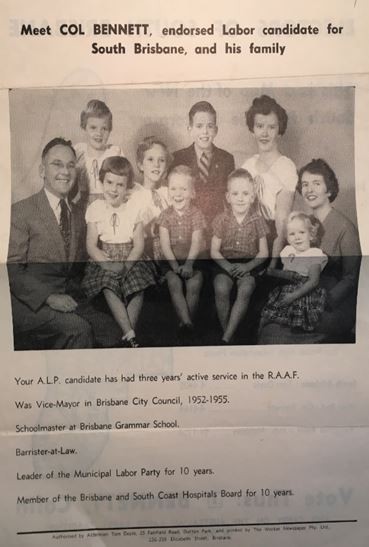
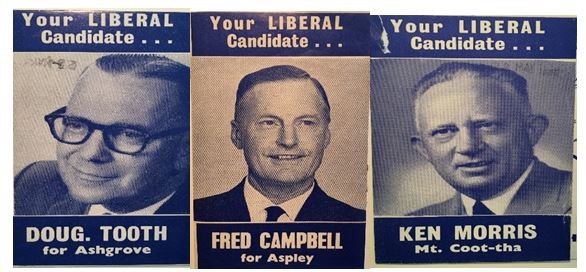
Images 12,13 and 14 - From SLQ's political ephemera collection
And parties are putting their messages on practical, multi-use items, such as this piece from Labor in 1966. This booklet opens up to promote the Labor candidate in Aspley, Jack Purtell, on the left and provide a shopping list on the right. On the back is a currency converter to help people when the country switched from imperial to decimal measures. There are conversion rates for common amounts of money and the cheeky tip that voters can convert the “old hillbilly Tory government” into a “new dynamic, Labor leadership”. (Images 15-17)

Images 15, 16 and 17 - From SLQ's political ephemera collection
Sometimes leaders are so dominant that they become known by just their first name, like Joh. Sir Joh Bjelke-Petersen governed from 1968 to 1987 and became the state’s longest-serving Premier (Image 18). He and his party understood the power of the image of a strong leader, and also the so-called halo effect of a popular leader. The halo effect is a marketing term that describes what happens when the positive associations of one product or brand are transferred to another product or brand. The same thing happens in politics when a powerful or popular leader is connected with a party, policy or candidate.
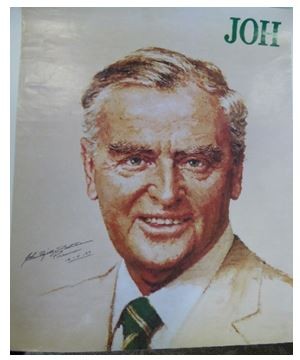
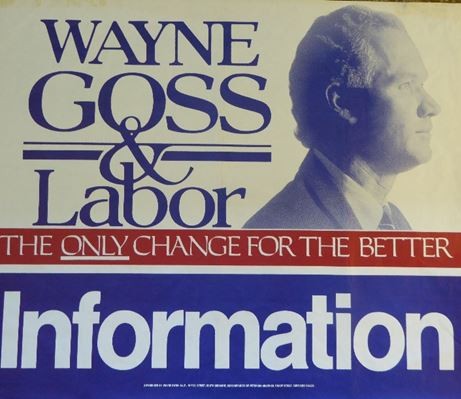
Image 19 - From SLQ's political ephemera collection
Labor led the pack when it came to political marketing, with consistent messaging and presentation. We see evidence of Labor’s professionalism in this campaign bulletin from the party’s head office to local campaign workers. The bulletin includes: results from most recent opinion poll; advice on how to campaign locally; policy summaries; draft media releases, event invitations and; order forms for Wayne Goss and Labor t-shirts. (Image 20)
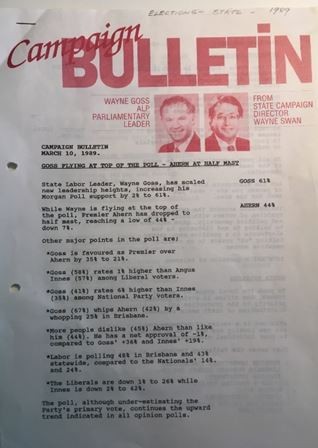
Image 20 - From SLQ's political ephemera collection
By the turn of the century, we are seeing a heavy focus on leaders, short slogans and strong visuals. In 2004, the Nationals’ marketing relied greatly on the new and energetic party leader, Lawrence Springborg, including via these life-size cardboard cut-outs. (Image 21) In 2009, Labor’s marketing also relied greatly on its new-ish leader, Anna Bligh, who was the state’s first female Premier. (Image 22) And the Liberal National Party campaign in 2012 focussed on Campbell Newman and the ‘CanDoQld’ slogan, which traded on the ‘Can Do’ nickname he earned during his years as the infrastructure-focused Brisbane Lord Mayor. (Image 23)
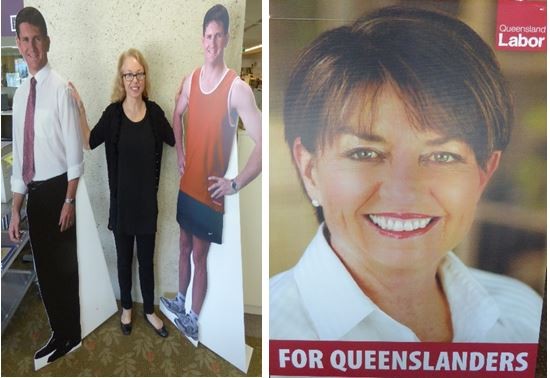
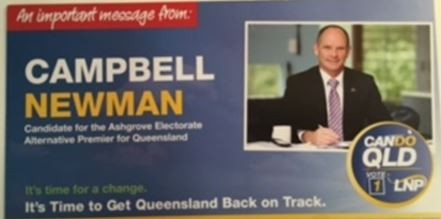
Image 23 - From SLQ's political ephemera collection
This piece from Labor’s 2015 campaign conveys a number of messages. First, it features the campaign slogan ‘A Better Way for Queensland’, which positions Labor leader, Annastacia Palaszczuk, against then-Premier Campbell Newman. After three years in office, Newman had developed a reputation for tough decisions, confrontations and dismissal of criticism. Below the slogan is an image of Palaszczuk standing with a group of eight. The people shown – an emergency services officer, a tradesman, two women with children, an older gent and a doctor – represent the voters that Labor is targeting in this campaign. This image is also designed to reinforce Palaszczuk’s reputation as approachable and consultative, in contrast to Newman’s perceived faults. (Image 24)
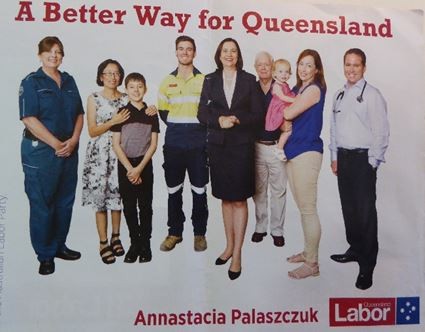
Image 24 - From SLQ's political ephemera collection
Political marketing isn’t confined to the major parties. One of the most consistent and recognisable political brands, and therefore one of the best, is the Australian Greens. Here, we see a how to vote card for the Greens candidate in Ashgrove in 2015, Robert Hogg. (Image 25) This material carries strong visuals and simple messages that reinforce the party’s long-term policies of environmental protection and social justice.
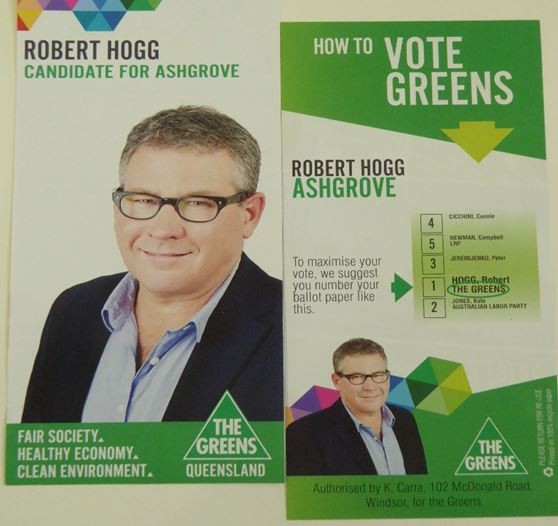
Image 25 - From SLQ's political ephemera collection
In reviewing the evolution of political marketing in Queensland, I’ve been able to showcase some of the ephemera collections of the John Oxley Library. Each piece of ephemera is a little time capsule. Each piece is important on its own and for its contribution to a larger story. With a rich collection of material, we can look across a sweep of history and see a fuller picture of our past.
The Library holds the country’s only collection of political ephemera from this state. It relies on donations so please feel free to offer any political ephemera you may have cluttering up your study or garage. You can send material to:
Election Ephemera
State Library of Queensland
PO Box 3488
South Brisbane QLD 4101
This is my final blog as the 2016 John Oxley Library Fellow, as my project wraps up on 30 June. Before then, I’ll be completing an annotated bibliography of the material I’ve reviewed. I’m photographing and describing each piece, talking a little about what it means in its historical context and including links for more information where relevant. I hope this work will be useful for future researchers.
My thanks to the State Library of Queensland and the Queensland Library Foundation for the opportunity to research the political ephemera collections. It’s been a privilege and a pleasure to work with this material and play a part in preserving and sharing our state’s history. Thanks also to all the staff of the John Oxley Library and especially Gavin Bannerman (Executive Manager, Queensland Memory), Mary Kajewski (Senior Project Officer), Libby Fielding (Legal Deposit Coordinator) and Simon Miller (Published Content Technician).
Further articles by Dr Lorann Downer
- Sectarian strife: Protestant versus Catholic in 1930s Queensland politics
- A woman’s place in political ephemera
- Not trash but treasure! Giving voice to political ephemera
Comments
Your email address will not be published.
We welcome relevant, respectful comments.